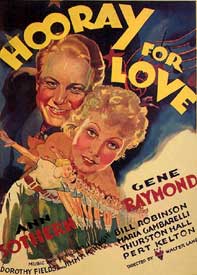 Thomas "Fats" Waller was one of the greatest stride piano players & composers of the jazz age. His broad humorous disposition made him beloved by all, but for jazz devottees who could see the true genius beneath the outrageous entertainer, he was really something special. Thomas "Fats" Waller was one of the greatest stride piano players & composers of the jazz age. His broad humorous disposition made him beloved by all, but for jazz devottees who could see the true genius beneath the outrageous entertainer, he was really something special.
Some have criticized over time the social context, which is racism, that caused many a black entertainer to present himself in a clowning manner, in essence mugging to the white audience, but I'm pretty sure performers like Fats & Satchmo were being humorous for black folk long before white folk caught on to how great they were.
For myself, I was first exposed to Fats Waller in old movies when I was a child, & I was instantly drawn to him. If his innocent funny manner gave him kid-appeal, it also assured that in old age, when the manner of presentation mattered less, the jazz remained with a powerful imprint.
He was not among us mortals nearly long enough, taken by pneumonia at age thirty-nine. But he was prolific in his lifetime & left a great body of work on recordings.
Nor is it too late to get a taste of his stage presence & his smile, for he has guest spots in a number of films, most wonderfully his last film appearance in Stormy Weather (1943), but also in a couple earlier films & a handful of soundies.
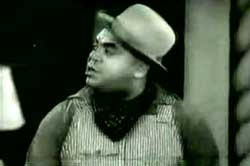 Fats has a guest roll in Hooray for Love (1935). This film in general has an indifferent story & Ann Sothern's attempt at being a singing star is not exactly embarrassing but it's not her greatest strength. She sings "I'm in Love All Over Again," "Palsy Walsy," & "You're An Angel." Pert Kelton sings "Birds of Spring." Fats has a guest roll in Hooray for Love (1935). This film in general has an indifferent story & Ann Sothern's attempt at being a singing star is not exactly embarrassing but it's not her greatest strength. She sings "I'm in Love All Over Again," "Palsy Walsy," & "You're An Angel." Pert Kelton sings "Birds of Spring."
All the songs are written by Dorothy Fields & Jimmy McHugh, excellent songwriters when at their best, but they're a bit uneven here. More of it might've seemed great with better singers; "I'm in Love All Over Again" is a better song than it seems in this arrangement & delivery. But then there's one phenomenal number to justify the entire show:
Bill "Bojangles" Robinson & Jenny Le Gon begin a duet of the Fields & McHugh composition "Livin' in a Great Big Way." Bojangles is in his trademark bowler hat. This is a super jazz number with witty lyrics:
"Got snap in my fingers, got rhythm in my walk/ As the elephant say, I'm livin' in a great big way/ Got a handful of nothin', & I watch it like a hawk/ Well I'm doin' okay, livin' in a great big way."
The number is cuted up with tiny little black children momentarily joining in, then Jenny & Bojangle do a lovely elegant soft-shoe & tap. Fats Waller is playing a furniture mover who sees the two dancer-singers & he starts dancing as he works, then sits down at a piano & adds to the instrumentation.
Bojangles & Jenny dance off stage, but Bojangles lingers to do some amusing jazz dialogue with Fats that leads into a reprise of the song for Bojangle & Fats, who manage each to have wildly different interpretations of the song & yet fit together so smoothly in their give & take exchange. Jenny will return for the vocal finale, & Bojangles closes on a softshoe with such simplicity & grace.
When Bojangles does a mouth impersonation of a horn & Fats yells out, "What's the mattah with him?" the moment stuck in the public mind, & was even caricatured in animated cartoons. In just about every cartoon that featured Bojangles Robinson & Fats Waller together -- & there are several -- it is their image in this film & in Stormy Weather that was re-echoed, example being Clean Pastures & Swing Wedding both from 1937.
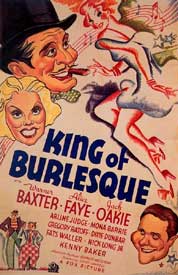 King of Burlesque (1936) is about the ups & downs of a burlesque producer (Warner Baxter) striving to move acts into the legitimate theater, defined as Broadway. It's also a tale of misdirected love leading to woe, followed by properly directed love leading to success in business as well as love.
King of Burlesque (1936) is about the ups & downs of a burlesque producer (Warner Baxter) striving to move acts into the legitimate theater, defined as Broadway. It's also a tale of misdirected love leading to woe, followed by properly directed love leading to success in business as well as love.
The story's okay but the last reel of the film is the reason this is a damned cool film, as it is practically a continuous Big Production Number.
Warner Baxter played the role of musical producer in a veritable trilogy of films. And though he doesn't have the same name he's essentially the same guy each time.
If you watch these three films back to back, you'll have kind of the story of that producer's rise: King of Burlesque shows his early days as a showman, his stumble, & his come-back; Stand Up & Cheer! (1934) shows him mid-career mixing politics & entertainment; & 42nd Street (1933) shows him at the height of his success, the greatest musical producer in the world.
The great entertainment imbedded in King of Burlesque includes The Paxton Sisters, Doris & Frances, a tapdance team, plus a whole array of wonderful dancers, who got the film an Oscar nomination for choreography.
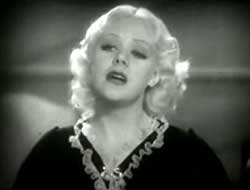 Additional starring dance moments are provided by Nick Long Jr who comes off as the Evil Knieval of tap, & Gareth Joplin who should've become as big as Bojangles after this but who knows why he didn't. Additional starring dance moments are provided by Nick Long Jr who comes off as the Evil Knieval of tap, & Gareth Joplin who should've become as big as Bojangles after this but who knows why he didn't.
Then there's the singers doing mostly though not exclusively Jimmy McHugh & Ted Koehler compositions. Alice Faye, usually with assistance, sings the Oscar-nominated "Shooting High," plus "I Love to Ride the Horses on a Merry-Go-Round," "Whose Big Baby Are You?" & "Spreading Rhythm Around." Kenny Baker sings "Lovely Lady."
Faye somewhat affects the manner of a platinum-blonde flapper of the 1920s. I rather like that sexy retro stylization but she would not do it in future films when she modernized her appearance & sang in a more normal voice.
The music in general is not bad. "Shooting High" is Faye's best number though when Jack Oaky impersonates Al Jolsen for his part of the duet, it's dragged down a bit. It will turn out to be the dancing that outpaces the songs; that is, until Fats Waller shows up. The film's totally stolen by the guest-spot for tapdancer Dixie Dunbar & our beloved stride piano-man.
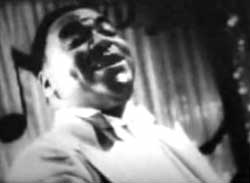 As was so often the case in those days in a mostly white-cast musical, Fats' performance is "segregated" & could be clipped out when distributing the film to white cinema houses in the south & still have a complete film. As was so often the case in those days in a mostly white-cast musical, Fats' performance is "segregated" & could be clipped out when distributing the film to white cinema houses in the south & still have a complete film.
Since it's by far the best sequence in the film, the punishment for any southerners not wanting to see it is they didn't get to see it. That, plus not to mention, by now they're all burning in hell if they never repented of racism.
And ph, what beauty, that big man clad in a white suit at a white piano, starting with some scat & a big slam on the keys. Fats performs the ultra-upbeat "I've Got My Fingers Crossed (Too Good To Be True)" playing stride while a little dixie land band backs him up, including trumpeter Teddy Buckner. The lyrics run in part:
"I've got my fingers crossed, not that I'm superstitious/ I'm afraid it's too good to be true/ I've got my fingers crossed, no wonder I'm suspicious/ I'm so gay, & the skies are much too blue."
Then out comes that slim tap dancer Dixie & Fats says, "Looky dare looky dare looky dare!" & sings to her pleasant tap routine backed by a top-hatted male chorus line.
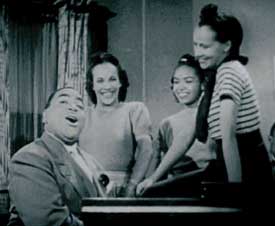 A straightforward performance in a three-minute visual jukebox soundie by Fats Waller, of the superb title song Ain't Misbehavin' (1941), is simply a thrilling wee film.
A straightforward performance in a three-minute visual jukebox soundie by Fats Waller, of the superb title song Ain't Misbehavin' (1941), is simply a thrilling wee film.
Waller at his piano is surrounded by adoring lovely ladies. The gals do a loosely choreographed "girls next door" chorus line dance very sweet & innocent.
Myra Johnson, who had sung with the Jimmie Lunceford orchestra in the previous decade, takes over the song at one point, a great interpretation without Waller's amusing slant, with plenty of character from Johnson so that she compares favorably to the lively pianist singing his own song.
It would've been so easy to fail beside one of the greatest of all jazz showmen, but Johnson's damned good.
There's pure innocence & charm to this small performance, despite a few sly daring moments. Given Hollywood's penchant for awful stereotyping, it's perhaps just as well nobody wrote a scenario for Fats, & just let him sing, even though I might've liked to see him be an actor too, in some context that permitted three songs rather than just the one.
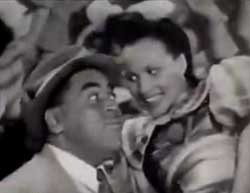 For Honeysuckle Rose (1941), once more girls are gathered around Waller's piano. Also lining up are some choras gals dancing, among whom will be spotted Myra Johnson being the most acrobatic. For Honeysuckle Rose (1941), once more girls are gathered around Waller's piano. Also lining up are some choras gals dancing, among whom will be spotted Myra Johnson being the most acrobatic.
Waller perhaps mugs a little too much this time, as he sings his classic number with a small band behind him. He solos for Al Casey on guitar & sax. The drummer is Slick Jones.
The method for making these soundies was the musicians would come one day & lay down the track in a sound studio, & usually the very next day would come onto a film stage for the film. It means the performances are unique to the soundies, but are not performed live.
For Fats this was a tough thing as he improved a great deal & no two performances were alike, yet he had to remember what he said in between song lyrics when he's being whimsical & making side-comments. Somehow he managed.
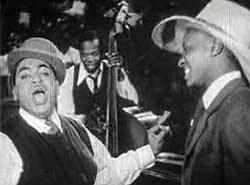 A dancer in a foolishly enormous white hat is dancing as Fats Waller plays piano in his bowler & sings Your Feets Too Big (1941), a song so great it completely transcends its "novelty tune" status.
A dancer in a foolishly enormous white hat is dancing as Fats Waller plays piano in his bowler & sings Your Feets Too Big (1941), a song so great it completely transcends its "novelty tune" status.
Since it's a corny funny song, Fats really camps it up. Dancer "Bugs" Hamilton, being handsome, picks up the gals easily enough, but has trouble dancing with 'em because his feets too big.
One of the gals has no choice but to climb on top of his feet & do a ride-around-on-em dance. He ends up dancing alone until Fats jumps down from the piano to joins him for a moment.
There's such a huge cast in this little film that it comes off as a big production instead of a little three-minute soundie. He was involved in the production end of soundies for himself & a couple chums, so chances are this is pretty much exactly the presentation he'd hoped for, nothing imposed on him.
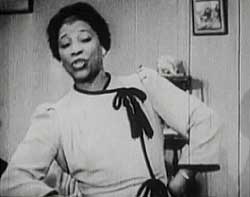 In 1945, Fats' 1941 soundies were stitched together in a home-movie one-reel film called A Fats Waller Medley. Missing from that reel is This Joint is Jumpin' (1942).
In 1945, Fats' 1941 soundies were stitched together in a home-movie one-reel film called A Fats Waller Medley. Missing from that reel is This Joint is Jumpin' (1942).
Backed by a combo & with the living room set crowded with dancers, Waller sings the title number with all his usual joy & mugging charm.
There's a quick-cut to outside, with an annoyed neighbor's face scowling from her window over the noise, then we're given the distinct impression that Fats' party attendees have been drinking a bit too much.
A fight almost breaks out, but Fats gets a handle on it reaching toward the combatants, then crying out for "Miss Johnson" to sing. Myra Johnson takes over the number, & what a fine performance she delivers.
More & more party-goers arrive. The apartment turns to standing room only, or jive jumplin' room only. The annoyed neighbor throws a shoe at Fats' window then calls the police. When three cops bust in, they see the gorgeous gals, hear the gorgeous music, & they start dancing too.
copyright © by Paghat the Ratgirl
|
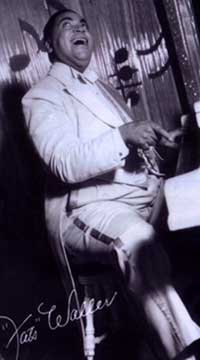

 Fats has a guest roll in Hooray for Love (1935). This film in general has an indifferent story & Ann Sothern's attempt at being a singing star is not exactly embarrassing but it's not her greatest strength. She sings "I'm in Love All Over Again," "Palsy Walsy," & "You're An Angel." Pert Kelton sings "Birds of Spring."
Fats has a guest roll in Hooray for Love (1935). This film in general has an indifferent story & Ann Sothern's attempt at being a singing star is not exactly embarrassing but it's not her greatest strength. She sings "I'm in Love All Over Again," "Palsy Walsy," & "You're An Angel." Pert Kelton sings "Birds of Spring."
 Additional starring dance moments are provided by Nick Long Jr who comes off as the Evil Knieval of tap, & Gareth Joplin who should've become as big as Bojangles after this but who knows why he didn't.
Additional starring dance moments are provided by Nick Long Jr who comes off as the Evil Knieval of tap, & Gareth Joplin who should've become as big as Bojangles after this but who knows why he didn't. As was so often the case in those days in a mostly white-cast musical, Fats' performance is "segregated" & could be clipped out when distributing the film to white cinema houses in the south & still have a complete film.
As was so often the case in those days in a mostly white-cast musical, Fats' performance is "segregated" & could be clipped out when distributing the film to white cinema houses in the south & still have a complete film.


